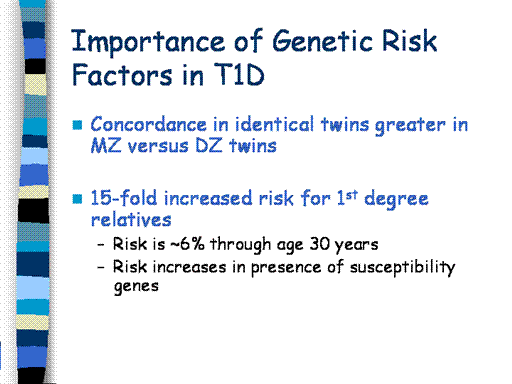| front |1 |2 |3 |4 |5 |6 |7 |8 |9 |10 |11 |12 |13 |14 |15 |16 |17 |18 |19 |20 |21 |22 |23 |24 |25 |26 |27 |28 |29 |30 |31 |32 |33 |34 |35 |36 |37 |38 |39 |40 |41 |42 |43 |44 |45 |46 |47 |48 |49 |50 |51 |52 |53 | 54 | review |
 |
There is also
evidence that T1D is, in part, a genetic disorder. Identical twins
(i.e., monozygous twins) are more likely to both have T1D than
non-identical twins (i.e., dizygous twins).
But concordance rates in identical twins are less than 50%,
supporting the hypothesis that environmental factors are also important
in the development of T1D.
Siblings of an
individual with T1D are about 15 times more likely to develop T1D than
individuals in the general population.
This translates to a cumulative risk of approximately 6% through
age 35 years. Interestingly,
children in families with a T1D mother have a lower risk (~3%) than
children in families with a T1D father (~6%),
reasons for which are unknown. One theory is that imprinting
plays a role in this phenomenon.
Imprinting refers to the lack of expression of a gene depending on the
gender of the parent who transmits it. If a maternal gene is imprinted,
it is turned off and only the paternal gene will be expressed.
The converse is true if the paternal gene is imprinted; the gene
from the father is turned off and the gene from the mother is expressed.
It is known that the insulin (INS) gene is located in a
region that is maternally imprinted (chromosome 11p15.5), but the
paternal INS gene is expressed.
This may explain the increased risk for children of diabetic
fathers.
|